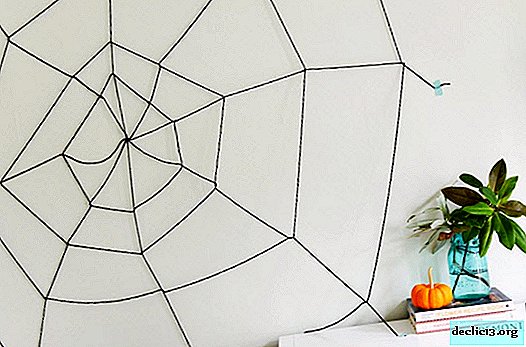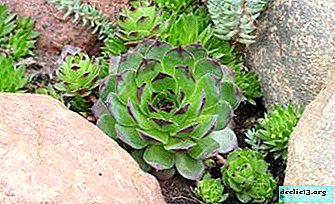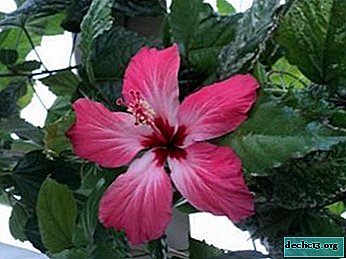Exotic notocactus - unpretentious guest from the foothills of South America
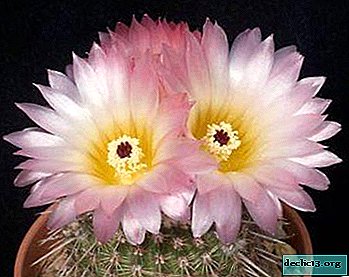
Exotic plants have always been an interesting and welcome guest for a home grower. However, often caring for them is time consuming. What to do if you want to get exotic at home, and there is no possibility or desire to take care of it carefully? In such a situation, an unpretentious southern guest can help out - notacactus. Notocactus is a popular species and is found in every collection of cacti. Plants differ in shape, color and appearance of thorns (leaves). They are not demanding in care, and the flowering is so amazing that no collector can resist this type of cactus.
General information
Notocactus, aka Notocactus, Brasilicactus, Eriocactus Parodia, is a group of plants with up to 25 species from the cactus family (Cactaceae). It is distinguished from most of the relatives in the class by the presence of a large, beautiful flower at the top of the stem.
The flower is funnel-shaped, growing on a short fleshy pedicle. The color of the flower varies from yellow to red. The cactus stem is single, low (from 10, but not more than 100 centimeters in height), differs in a spherical or cylindrical shape of a dark green color. On the edges of the cactus there are small tubercles on which areoles with a slight pubescence are located. Spines grow from areoles, from 1-3 large, to 35 smaller.
In the wild, this beauty grows in South America, Bolivia, Brazil, Uruguay and Paraguay, as well as Argentina. For his place of residence, he mainly chooses hills covered with tall grass and shrubs, loves shading. Sometimes it can be found on rocks and cliffs.
Reference: "notus" in Latin means "south", which gives a very vivid description of notocactus - "southern", does not tolerate cold. The plant was first discovered by the German botanist Karl Schumann in the 18th century.The main types and their photos
Notocactus Uebelmanius

The cactus is spherical-flattened, the height is from 12 to 16 centimeters, the thickness of the stem is about 16 cm in diameter. It practically does not form lateral shoots, up to five red flowers can form on the top of the cactus stem during flowering
Haselbergius (Hazelberg)

A plant with a slightly elongated stem, height from 12 to 15 centimeters and a small diameter - from 5 to 10 centimeters. During flowering, produces several flowers. up to 2 centimeters in size.
Notocactus Ottonis (Notocactus Otto)

The stem is usually in the form of a ball, up to 15 centimeters in diameter. Releases quite a few root shoots. It also has a small number (1-2) of yellow flowers.
Magnificus (magnificent)

Has a spherical stalk up to 16 centimeters high, reaches a diameter of up to 15 centimeters, produces many basal shoots. Stem color - green with a blue tint. In summer, it blooms with grayish-yellow several flowers.
Apricus (sunflower)

It is a slightly flattened stalk with a lot of areoles. During flowering, usually gives two large flowers (up to 10 centimeters in size!) Of a yellow-red hue.
Tabularis (flat)

Has a flattened apex and wide ribs. Its flowers are quite large (up to 8 centimeters in diameter).
Each species also has several subspecies., which may differ from the main color of flowers and needles.
Read more about the types of notocactus described here.
Home Plant Maintenance
This representative of the flora is completely unpretentious, which greatly facilitates the care of him at home. You should consider some of the most important nuances associated with the content of this cactus at home.
Lighting
Notocactus, like any other cacti, loves sunlight very much and needs it. For the location of this plant, it is worth choosing a place where nothing will impede direct sunlight.
Important! The scorching rays of the sun can harm the cactus! Until the burns!It is necessary to obscure the location in such cases. A piece of gauze or tracing paper is suitable for shading. For the most complete ripening of flowers, in winter, the plant should be illuminated with the so-called "phytolamps" for at least 10 hours a day.
Watering
In spring and summer, it is necessary to water the cactus so that the substrate in which it grows does not dry completely. At the same time, you should not water the pet too much, since it can begin to rot on the roots. In the colder season, in autumn and winter, the size of irrigation can be reduced to moderate. It is important to prevent the drying of the earth in a pot!
To water the notocactus, it is highly recommended to use settled water at room temperature. You can also use clean rain or melt water.
Temperature
 Notocactus is a thermophilic pet, prefers a temperature ranging from 22 to 26 degrees Celsius.
Notocactus is a thermophilic pet, prefers a temperature ranging from 22 to 26 degrees Celsius.
However, he will not suffer from higher temperatures. It is also advisable that the air in the room is regularly ventilated.
In the warm season it will be useful to bring the plant to the balcony. In winter, the temperature in the room where the cactus is located should not fall below 10 degrees Celsius, otherwise it can simply freeze and die.
Soil selection
It is recommended to opt for loose consistency, clay soil, with large river sand contained in its composition. Peat in the substrate is also desirable. In specialized stores you can also buy a ready-made version of the soil for cacti - but it is advisable to "dilute" it with river sand so that this sand is visible.
Suitable pots
Insofar as cactus does not tolerate large amounts of fluid in the earth on which it growstherefore, it is worth picking up a pot that will help protect the roots of the plant from excess water and, as a result, rotting them.
For such purposes, you need a tank with a drainage property, as well as the function of heat storage as long as possible. Such qualities have pots made of clay, with holes for leaving excess water in the bottom. You can use plastic containers, but then you should take care of observing the temperature regime, since plastic retains heat much less than ceramic.
Due to the gradual growth of roots and root processes of notocactus, it is necessary to select a pot of a sufficiently large diameter and size.
Pruning
Despite the fact that notocactus grows rather slowly, they need to be trimmed periodically. When they reach more than 17 centimeters in height, the top should be trimmed with a sharp secateurs. Then the place of cut should be “sharpened”, made like a pencil, to prevent cactus from being drawn in. After this, the notocactus should be allowed to dry for a week - to do this, reduce regular watering.
Do not make the cut too small; this may cause the plant to dry!
Transfer
Paying attention to the slow growth of this representative of the flora, it is often not necessary to transplant it. It is only necessary to make sure that the roots of the cactus do not begin to bulge out of the pot - this signals that the time for transplantation has come. The best time to transplant to a new place is the winter period, because at this time of the year the growth of the plant slows down even more.
Transplant Actions:
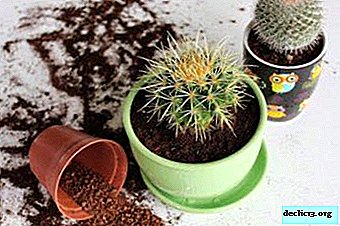 It is necessary to stop watering the plant three days before moving to a new pot.
It is necessary to stop watering the plant three days before moving to a new pot.- On the day of transplantation, carefully remove the top layer of earth in the pot, and carefully wrapping the notocactus with newspaper or cloth, remove it from the old place.
- Next, you need to clean the roots of adhering soil, cut off rotten roots.
- Then lower the cactus into a new, larger pot, and gradually fill it with fresh substrate, periodically gently tapping the container on a hard surface so that the soil is evenly distributed.
- You should stop fertilizing the plant.
- Reduce the amount of watering (once every three weeks, in small portions to avoid drying out).
- In case of breeding by seeds.
- day hold in a disinfectant solution of potassium permanganate;
- then the seeds are planted in the ground and kept at a temperature of at least 25 degrees Celsius.
- Reproduction by processes. Since propagation by seeds is rather difficult and requires special care and attention, usually notocactus is propagated by processes.
- it is necessary to separate the appeared process from the main stem;
- put in a prepared container with ground.
- Rebucia.
Spherical cactus growing in Bolivia. A smaller, compared with the plant we are considering - on average, reaches a size of 9 centimeters. Read more about rebuts here.
- Cephalocereus
It also grows slowly, produces flowers that look like a bunch of gray hair, which is why its name is translated from Latin "old man's head".
- Echinopsis.
Also has a stalk in the form of a flattened ball, or elongated. It differs in inflorescences growing not from the very top of the stem, but from the sides.
- Ariocarpus
Extremely interesting cactus that does not have thorns (read about cacti without thorns here). The stalk is flattened, the processes from it are triangular. Also sprouts a large flower at the apex.
- Gymnocalycium.
Spherical main stem growing from 3 to 30 centimeters! Blooms with several inflorescences from the top.
Top dressing
Fertilizing a growing organism is recommended during the warm seasonwhen the cactus is in the active phase of growth. It is enough once or twice a week.
Attention! It is best to fertilize the notocactus with a special potassium-containing fertilizer for cacti purchased at the store.Biological fertilizers, on the contrary, are undesirable to use, since this plant requires potassium.
Winter care
In winter, there are certain nuances in the care of notactactus, namely:
In order to avoid drying out, it is also necessary to protect the location from the thermal effect of heating devices.
Actions after the purchase
When purchasing a flower, you should pay attention to its appearance. All kinds of clusters of red dots, unnatural-looking spots on the cactus itself, spider-like balls on the ground indicate the presence of parasites! Such a plant should not be purchased. If the condition of the flower upon purchase is satisfied, bringing it home, you should limit it from other plants for a week. Then you need to transplant the notocactus into a new pot.
Breeding
This representative of the cactus family propagates in two ways - by processes from the stem or root, or by flower seeds.
With sufficient light and heat, the new plant will take root easily and continue to grow.
Bloom
Flowers of such cacti are diurnal, that is, bloom in the light of day. Usually, the period of flower growth occurs in the warm season (March-July). Flowering lasts up to three months. In autumn and winter, notactactus slows down its internal processes, and does not bloom.
Video how the flower of notocactus blooms:
Diseases and Pests
 The most common parasites on the body of this cactus are spider mites, mealy worms, and scale insects (similar to aphids). It is difficult to detect the presence of pests due to the small size of the plant itself.
The most common parasites on the body of this cactus are spider mites, mealy worms, and scale insects (similar to aphids). It is difficult to detect the presence of pests due to the small size of the plant itself.
The spider mite, according to the name, leaves cobwebs on the needles and stalk, small yellow or brownish spots appear from the scutellum, but the worm can be indexed by the products of its vital activity remaining on the soil - white "cotton" spherical growths.
If signs of the disease are detected, immediately treat the “diseased” flower with a special preparation. (can be found in specialized stores).
Similar flora
A few of the most similar flowers should be highlighted.
Thus, growing notactactus at home is not a complicated procedure. An extremely unpretentious plant will delight the owner with beautiful bright flowers in the warm season.

 It is necessary to stop watering the plant three days before moving to a new pot.
It is necessary to stop watering the plant three days before moving to a new pot.






